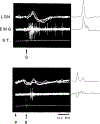Lateral geniculate spikes, muscle atonia and startle response elicited by auditory stimuli as a function of stimulus parameters and arousal state
- PMID: 2804671
- PMCID: PMC9045736
- DOI: 10.1016/0006-8993(89)91130-x
Lateral geniculate spikes, muscle atonia and startle response elicited by auditory stimuli as a function of stimulus parameters and arousal state
Abstract
We have investigated the motor and ponto-geniculo-occipital (PGO) wave response to startle eliciting stimuli in the unanesthetized cat. We found that the amplitude of the PGO spike recorded in the lateral geniculate nucleus (LGN) increases monotonically with increasing intensities of auditory stimuli. In contrast, the motor response to low intensity (less than 75 dB) stimuli is characterized by electromyographic (EMG) suppression, while at higher intensities an EMG excitation is superimposed on this suppression. Thus PGO elicitation is accompanied by EMG suppression at low intensities and by a net EMG excitation at high intensities. While the amplitude of the auditory elicited PGO response is a graded function of stimulus intensity, somatic stimuli tend to elicit the PGO response in all-or-none fashion. Both the motor and PGO responses to sensory stimulation change with behavioral state. The EMG suppression by auditory stimulation increases in duration during the transition to rapid eye movement (REM) sleep. Elicited PGO amplitude is highest in transitional sleep, lower in quiet waking and REM sleep and lowest in active waking. Prepulse inhibition of PGO spikes is greatly attenuated during transitional and REM sleep. We hypothesize the existence of 3 phasic response systems, a motor suppression system, a motor excitation (startle) system and a PGO elicitation system. While these systems are triggered concurrently by intense phasic stimuli in waking, they are modulated independently by stimulus intensity and behavioral state, and have different rates of habituation. These systems act in concert to produce behavioral responses to sudden onset stimuli.
Figures









Similar articles
-
Facilitation of the acoustic startle reflex by ponto-geniculo-occipital waves: effects of PCPA.Brain Res. 1990 Nov 5;532(1-2):237-41. doi: 10.1016/0006-8993(90)91765-9. Brain Res. 1990. PMID: 2149298 Free PMC article.
-
Relationship between sensory stimuli-elicited IPSPs in motoneurons and PGO waves during cholinergically induced muscle atonia.J Neurophysiol. 1997 Oct;78(4):2145-55. doi: 10.1152/jn.1997.78.4.2145. J Neurophysiol. 1997. PMID: 9325381
-
Elicited pontogeniculooccipital waves and phasic suppression of diaphragm activity in sleep and wakefulness.J Appl Physiol (1985). 1998 Jun;84(6):2106-14. doi: 10.1152/jappl.1998.84.6.2106. J Appl Physiol (1985). 1998. PMID: 9609806
-
Paradoxical sleep and its chemical/structural substrates in the brain.Neuroscience. 1991;40(3):637-56. doi: 10.1016/0306-4522(91)90002-6. Neuroscience. 1991. PMID: 2062436 Review.
-
The Ponto-Geniculo-Occipital (PGO) Waves in Dreaming: An Overview.Brain Sci. 2023 Sep 20;13(9):1350. doi: 10.3390/brainsci13091350. Brain Sci. 2023. PMID: 37759951 Free PMC article. Review.
Cited by
-
Facilitation of the acoustic startle reflex by ponto-geniculo-occipital waves: effects of PCPA.Brain Res. 1990 Nov 5;532(1-2):237-41. doi: 10.1016/0006-8993(90)91765-9. Brain Res. 1990. PMID: 2149298 Free PMC article.
-
Cholinergic mechanisms in startle and prepulse inhibition: effects of the false cholinergic precursor N-aminodeanol.Behav Neurosci. 1993 Apr;107(2):306-16. doi: 10.1037//0735-7044.107.2.306. Behav Neurosci. 1993. PMID: 8097917 Free PMC article.
-
Cholinergic neurons in the pedunculopontine tegmental nucleus are involved in the mediation of prepulse inhibition of the acoustic startle response in the rat.Exp Brain Res. 1993;97(1):71-82. doi: 10.1007/BF00228818. Exp Brain Res. 1993. PMID: 8131833
-
Auditory inhibition of rapid eye movements and dream recall from REM sleep.Sleep. 2009 Mar;32(3):399-408. doi: 10.1093/sleep/32.3.399. Sleep. 2009. PMID: 19294960 Free PMC article. Clinical Trial.
-
Phasic activation of the locus coeruleus attenuates the acoustic startle response by increasing cortical arousal.Sci Rep. 2021 Jan 14;11(1):1409. doi: 10.1038/s41598-020-80703-5. Sci Rep. 2021. PMID: 33446792 Free PMC article.
References
-
- Barnes CD and Thomas JS, Effects of acoustic stimulation on the spinal cord, Brain Research, 7 (1968) 303–305. - PubMed
-
- Bennett MVL, Escapism: some startling revelations. In Eaton RC (Ed.), Neural Mechanisms of Startle Behavior, Plenum, New York, 1984, pp. 353–363.
-
- Berlucchi G, Munson JB and Rizzolatti G, Changes in click-evoked responses in the auditory system and the cerebellum of free-moving cats during sleep and waking, Arch. Ital. Biol, 105 (1967) 118–135. - PubMed
-
- Bizzi E and Brooks DC, Functional connections between pontine reticular formation and lateral geniculate nucleus during deep sleep, Arch. Ital. Biol, 101 (1963) 666–680. - PubMed
-
- Bowker RM, The awakening of the sleeping ponto-geniculo-occipital wave. In Koell WP (Ed.), Sleep, S. Karger, Basel, 1980, pp. 304–306.
Publication types
MeSH terms
Grants and funding
LinkOut - more resources
Full Text Sources
Other Literature Sources
Miscellaneous

